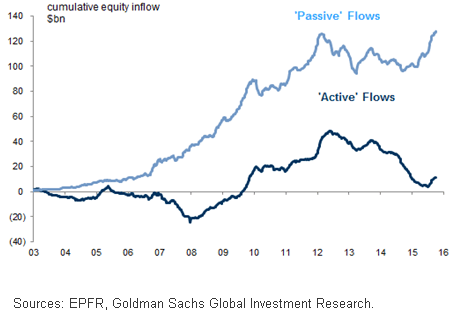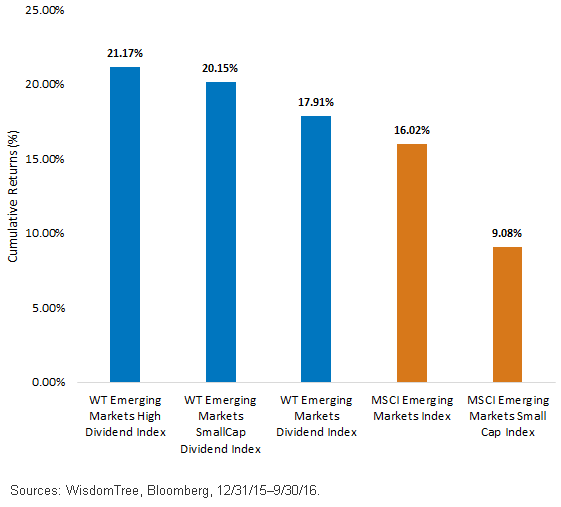Are Passive Flows Driving Emerging Markets?


One of most commonly held beliefs I have seen over the years is that inefficient markets—such as emerging markets (EM)—are where there are great opportunities for active managers to add value. What isn’t often said is that if there is a large opportunity to outperform, there is an equally large opportunity to underperform—someone must be on the other side of the “inefficiencies.”
Goldman Sachs strategists Caesar Maasry and Jane Wei wrote an interesting note about how the trends toward exchange-traded funds (ETFs) and passive strategies have been affecting EM asset prices. Goldman Sachs pointed out that large ETF flows have been associated with “(1) the sharp rise of EM asset prices, (2) the underperformance of EM actively managed funds, and (3) the rotation out of EM small caps into large caps.”1
One of the more interesting charts in the note showed the cumulative flows for passive strategies in the emerging markets compared to active strategies over the last 13 years.
Active EM equity strategies have garnered less than $20 billion of cumulative flows over the period of Goldman Sachs’s analysis, while passive flows have cumulatively seen more than $110 billion of inflows.
Investors seem to be voting that passive strategies are the preferred asset allocation vehicle. One reason is the long-term performance record of passive strategies. What explains the recent performance edge?
Active and Passive Flows During Similar Periods

The Goldman Sachs strategists declared, “EM active managers’ recent underperformance is explained by their positioning.” They went on to say the following:
Based on our sample of the 50 largest actively-managed EM funds, managers appear to have underperformed in recent months (130 basis points (bps) since end-May) after posting 100 bps of positive alpha earlier in the year.
Put more simply, EM managers appear to be defensively positioned […they are over-weight in low-beta markets such as India and Mexico]. Here, we argue that this defensive allocation has been true since the peak of MSCI EM in 2010.
We find this to be the primary factor in explaining active fund underperformance, rather than flow dynamics.
What moved in emerging markets this year are the really out-of-favor value-like exposures in countries such as Brazil, Russia and commodity-centric plays.
If investors are increasing allocations to emerging markets today, we’d ask what they’re looking for. One common argument for increasing emerging markets weights in portfolios is the relatively low valuations compared to more developed markets such as the United States.
For those investors looking to capture this valuation advantage, we’d suggest looking at passive factor strategies that focus on these depressed valuations, rather than relying on an active manager who appears more defensively biased or a strategy tracking a market cap index, which follows momentum and rides sectors that are out of favor into lower weights—never increasing their exposure systematically with a value-seeking mindset.
Dividend Approach Adding Value in 2016
We have been writing about the annual rebalance that WisdomTree’s EM dividend Indexes undertook in October. This has been a year of strong gains in commodity prices and commodity countries.
• Deeper Value Tilts: The WisdomTree Emerging Markets High Dividend Index has been our best-performing strategy in 2016, and a large part of that was because of its sector exposure to Energy and Materials, which was twice that of the MSCI Emerging Markets Index. We wrote about its latest rebalance here.
• Small Caps: Although Goldman Sachs mentioned that investors appear to be rotating out of small caps into large caps, we find that, year-to-date, the WisdomTree Emerging Markets SmallCap Dividend Index has outperformed the MSCI Emerging Markets Index and the MSCI Emerging Markets Small Cap Index by an even greater magnitude. Part of that was due to country allocations that came with a dividend approach that included large allocations to Brazil. We wrote about its rebalance here.
WisdomTree Cumulative YTD Performance versus MSCI Indexes

One of the key factors of WisdomTree’s passive methodology is a rebalancing discipline that favors the parts of the markets with growth in fundamentals and better valuations. The Index methodology lowers weight in stocks, sectors and countries that are getting more expensive as measured by their price gains compared to their dividend growth.
While active managers appear defensively positioned according to Goldman Sachs, the WisdomTree dividend strategies, which typically have a defensive approach, have had returns that have been greater than the market in 2016 with country and sector allocations that might be considered more aggressively positioned.
We’d note that if investors are rotating into emerging markets because of relatively low valuations, WisdomTree’s strategies tend to have more attractive valuation multiples than the MSCI and traditional cap-weighted indexes.
The rebalance that occurred in October is another time when those valuation ratios were reset, and generally they decreased—whether seen from a price/earnings ratio perspective or a dividend yield perspective.
We think now is a good time to reconsider how one is allocating to emerging markets with passive approaches.
1Caesar Maasry, Jane Wei, “Global Markets Daily: Active vs. Passive and the EM Alpha Challenge” 10/13/16.
Important Risks Related to this Article
Investments in emerging, offshore or frontier markets are generally less liquid and less efficient than investments in developed markets and are subject to additional risks, such as risks of adverse governmental regulation and intervention or political developments.Dividends are not guaranteed, and a company currently paying dividends may cease paying dividends at any time.

Jeremy Schwartz has served as our Global Chief Investment Officer since November 2021 and leads WisdomTree’s investment strategy team in the construction of WisdomTree’s equity Indexes, quantitative active strategies and multi-asset Model Portfolios. Jeremy joined WisdomTree in May 2005 as a Senior Analyst, adding Deputy Director of Research to his responsibilities in February 2007. He served as Director of Research from October 2008 to October 2018 and as Global Head of Research from November 2018 to November 2021. Before joining WisdomTree, he was a head research assistant for Professor Jeremy Siegel and, in 2022, became his co-author on the sixth edition of the book Stocks for the Long Run. Jeremy is also co-author of the Financial Analysts Journal paper “What Happened to the Original Stocks in the S&P 500?” He received his B.S. in economics from The Wharton School of the University of Pennsylvania and hosts the Wharton Business Radio program Behind the Markets on SiriusXM 132. Jeremy is a member of the CFA Society of Philadelphia.

